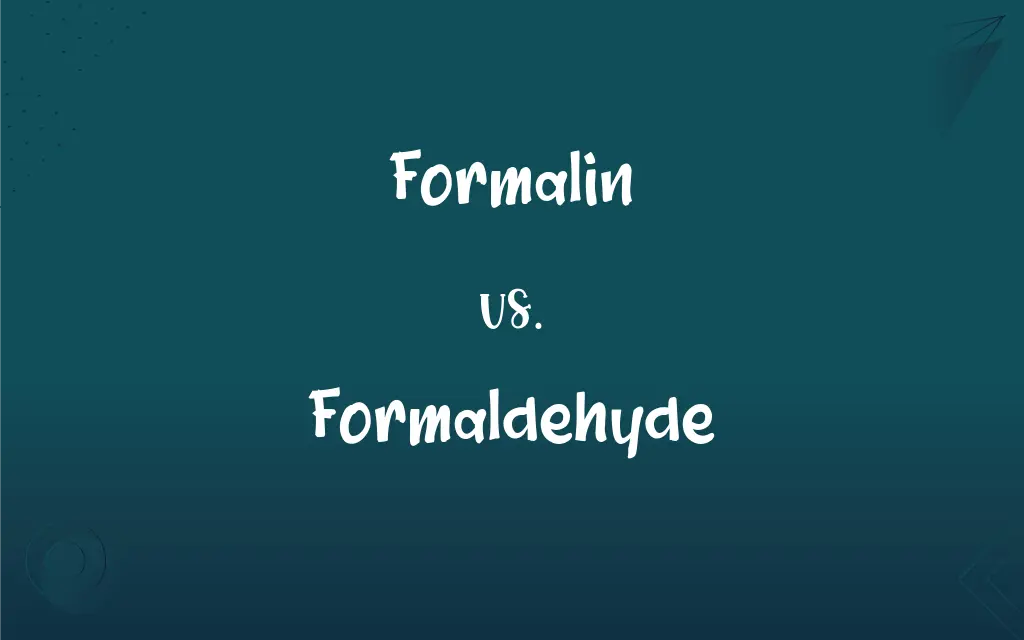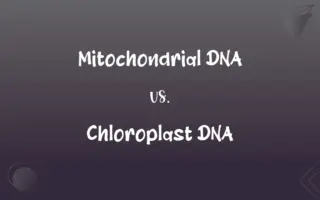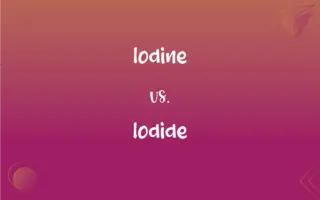Formalin vs. Formaldehyde: What's the Difference?
Edited by Aimie Carlson || By Janet White || Published on January 18, 2024
Formalin is a solution of formaldehyde in water, typically about 37-40% formaldehyde by volume. Formaldehyde is a volatile, colorless gas at room temperature.

Key Differences
Formalin is a liquid solution, commonly used as a preservative and disinfectant, which contains a percentage of formaldehyde gas dissolved in water. Formaldehyde itself is a gas at room temperature, known for its strong, pungent smell.
The concentration of formaldehyde in formalin is usually around 37-40% by volume, mixed with water and often a small percentage of methanol. Pure formaldehyde, on the other hand, exists as a gas and is rarely encountered in its pure form outside of industrial settings.
Formalin's application in biological specimen preservation is well-known, owing to its ability to crosslink proteins. Formaldehyde gas is more commonly used in industrial processes, such as in the production of resins and as a chemical intermediate.
The safety measures for handling formalin are crucial due to its toxic nature, especially in preventing skin and respiratory exposure. Formaldehyde gas is also hazardous, necessitating safety protocols to avoid inhalation and direct contact.
In medical laboratories, formalin is a staple for tissue fixation and pathology. Formaldehyde, as a gas, finds use in various sterilization and disinfection processes.
ADVERTISEMENT
Comparison Chart
Physical State
Liquid solution
Gas at room temperature
Composition
About 37-40% formaldehyde in water
Pure formaldehyde gas
Uses
Preservative, disinfectant, tissue fixation
Industrial production, sterilization
Handling Safety
Toxic, requires careful handling and storage
Highly volatile and hazardous
Common Form
Commonly available in diluted form for use
Rarely encountered in pure gaseous form
ADVERTISEMENT
Formalin and Formaldehyde Definitions
Formalin
Formalin serves as a disinfectant.
The equipment was sterilized using formalin.
Formaldehyde
Formaldehyde is a colorless, pungent gas.
The sharp smell indicated the presence of formaldehyde.
Formalin
Formalin is known for its strong odor.
The distinct smell in the lab was due to formalin.
Formaldehyde
It's used in the production of resins.
Formaldehyde is a key ingredient in this resin.
Formalin
It is a potent fixative for histology.
Formalin fixed the tissue slices for microscopic examination.
Formaldehyde
It acts as a sterilizing agent.
Formaldehyde gas was used for sterilization purposes.
Formalin
Formalin is a water-based solution of formaldehyde.
The specimen was preserved in formalin for study.
Formaldehyde
Formaldehyde can be hazardous.
Proper precautions are necessary when handling formaldehyde.
Formalin
It's used as a preservative in labs.
Formalin is essential for maintaining tissue samples.
Formaldehyde
Formaldehyde is a chemical intermediate.
Several synthetic pathways begin with formaldehyde.
Formalin
An aqueous solution of formaldehyde that is 37 percent by weight, usually also containing 10 to 15 percent methanol to prevent polymerization of the formaldehyde.
Formaldehyde
A pungent colorless flammable gaseous compound, CH2O, the simplest and most reactive aldehyde, used for manufacturing melamine and phenolic resins, fertilizers, dyes, and embalming fluids and in aqueous solution as a preservative and disinfectant.
Formalin
A solution of formaldehyde in water; used as a disinfectant and to preserve biological specimens.
Formaldehyde
(organic compound) The simplest aldehyde, HCHO, a colourless gas that has many industrial applications; it dissolves in water to give formol (10%) and formalin.
Formalin
An aqueous solution of formaldehyde, used as a preservative in museums and as a disinfectant.
Formaldehyde
A colorless, volatile liquid, H2CO, resembling acetic or ethyl aldehyde, and chemically intermediate between methyl alcohol and formic acid.
Formalin
A 10% solution of formaldehyde in water; used as a disinfectant or to preserve biological specimens
Formaldehyde
A colorless poisonous gas; made by the oxidation of methanol
FAQs
What are the uses of formalin?
Formalin is used for preserving biological specimens and as a disinfectant.
How is formalin different from formaldehyde?
Formalin is a diluted, liquid form of formaldehyde, which is a gas.
What are the uses of formaldehyde?
Formaldehyde is used in making resins, as a chemical intermediate, and for sterilization.
What is formalin?
Formalin is a solution of formaldehyde gas dissolved in water, often used for preservation.
What is formaldehyde?
Formaldehyde is a colorless, strong-smelling gas used in various industrial processes.
Can formalin be used in embalming?
Yes, formalin is commonly used in the embalming process.
Is formalin dangerous?
Yes, formalin is toxic and requires careful handling.
How is formaldehyde stored?
Formaldehyde, as a gas, requires secure, leak-proof containers and appropriate ventilation.
What is the concentration of formaldehyde in formalin?
Formalin typically contains about 37-40% formaldehyde by volume.
Is formaldehyde dangerous?
Formaldehyde is hazardous, particularly as a gas, and can be irritant and toxic.
Is formaldehyde found in household products?
Yes, formaldehyde is present in some household products, often in a bound form.
Are there natural sources of formaldehyde?
Yes, formaldehyde is naturally present in small amounts in various organic processes and environments.
What precautions are needed when handling formalin?
Proper ventilation, gloves, and protective eyewear are essential when handling formalin.
Is formaldehyde used in vaccines?
Formaldehyde is used in the production of some vaccines, but it's not present in the final product.
How is formalin stored?
Formalin should be stored in a cool, well-ventilated area, away from direct sunlight.
Can formaldehyde cause allergic reactions?
Yes, formaldehyde exposure can cause allergic reactions in some individuals.
What safety measures are needed for formaldehyde?
Adequate ventilation, protective clothing, and avoidance of inhalation are crucial for formaldehyde.
Can formalin be used for sterilization?
Yes, formalin can be used for sterilizing medical and laboratory equipment.
Is formalin used in food preservation?
No, formalin is not suitable for food preservation due to its toxicity.
Can formaldehyde be found in cosmetics?
Some cosmetics may contain formaldehyde-releasing preservatives.
About Author
Written by
Janet WhiteJanet White has been an esteemed writer and blogger for Difference Wiki. Holding a Master's degree in Science and Medical Journalism from the prestigious Boston University, she has consistently demonstrated her expertise and passion for her field. When she's not immersed in her work, Janet relishes her time exercising, delving into a good book, and cherishing moments with friends and family.
Edited by
Aimie CarlsonAimie Carlson, holding a master's degree in English literature, is a fervent English language enthusiast. She lends her writing talents to Difference Wiki, a prominent website that specializes in comparisons, offering readers insightful analyses that both captivate and inform.






































































